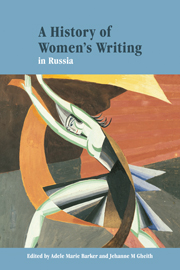Book contents
- Frontmatter
- Contents
- Notes on contributors
- Acknowledgments
- Note on transliteration
- List of abbreviations
- Introduction
- 1 Women's image in Russian medieval literature
- 2 Sappho, Corinna, and Niobe: genres and personae in Russian women's writing, 1760–1820
- 3 The inexperienced muse: Russian women and poetry in the first half of the nineteenth century
- 4 Women of the 1830s and 1850s: alternative periodizations
- 5 “A particle of our soul”: prerevolutionary autobiography by Russian women writers
- 6 The women of Russian Montparnasse (Paris, 1920–1940)
- 7 Women in Russian Symbolism: beyond the algebra of love
- 8 The eastern path of exile: Russian women's writing in China
- 9 Realist prose writers, 1881–1929
- 10 Women and gender in post-symbolist poetry and the Stalin era
- 11 Writing the female body politic (1945–1985)
- 12 In their own words? Soviet women writers and the search for self
- 13 Women's poetry since the sixties
- 14 The persistence of memory: women's prose since the sixties
- 15 Perestroika and post-soviet prose: from dazzle to dispersal
- Bibliographical guide to writers and their works
- Guide to further reading
- Index
1 - Women's image in Russian medieval literature
Published online by Cambridge University Press: 22 September 2009
- Frontmatter
- Contents
- Notes on contributors
- Acknowledgments
- Note on transliteration
- List of abbreviations
- Introduction
- 1 Women's image in Russian medieval literature
- 2 Sappho, Corinna, and Niobe: genres and personae in Russian women's writing, 1760–1820
- 3 The inexperienced muse: Russian women and poetry in the first half of the nineteenth century
- 4 Women of the 1830s and 1850s: alternative periodizations
- 5 “A particle of our soul”: prerevolutionary autobiography by Russian women writers
- 6 The women of Russian Montparnasse (Paris, 1920–1940)
- 7 Women in Russian Symbolism: beyond the algebra of love
- 8 The eastern path of exile: Russian women's writing in China
- 9 Realist prose writers, 1881–1929
- 10 Women and gender in post-symbolist poetry and the Stalin era
- 11 Writing the female body politic (1945–1985)
- 12 In their own words? Soviet women writers and the search for self
- 13 Women's poetry since the sixties
- 14 The persistence of memory: women's prose since the sixties
- 15 Perestroika and post-soviet prose: from dazzle to dispersal
- Bibliographical guide to writers and their works
- Guide to further reading
- Index
Summary
Until comparatively recently, both literary and historical criticism of the female image in medieval Russia has too often drawn a gloomy picture of inequality, repression, and suffering. With very limited exception, prerevolutionary analysis of the female image was occupied with women's legal, sociopolitical, and family status. Even the stalwarts of twentieth-century criticism, such as D. S. Likhachev and I. P. Eremin, produced no specific examination of the evolution of female characters, concentrating rather on questions of form and generic classification. Furthermore, the absence of women writers in the medieval period and a preponderance of ecclesiastical female stereotypes have encouraged primarily historically based analysis, to the detriment of the literary portrait.
No work of literature written by a woman has come down to us; indeed, it was very rare for women to be literate as access to education was denied to them. In the cases where aristocratic ladies were taught to read, this was solely for devotional purposes such as reading of the Holy Scriptures and life-stories of the Orthodox saints. Until the seventeenth century, there was little alternative reading material — only a few travel accounts and historical works. Writing (and reading) was quite simply considered neither a profession, nor a general instructive or pleasurable activity; rather, it was a sacred task undertaken by the male clergy for the teaching and dissemination of Orthodox Christianity.
- Type
- Chapter
- Information
- A History of Women's Writing in Russia , pp. 16 - 36Publisher: Cambridge University PressPrint publication year: 2002



